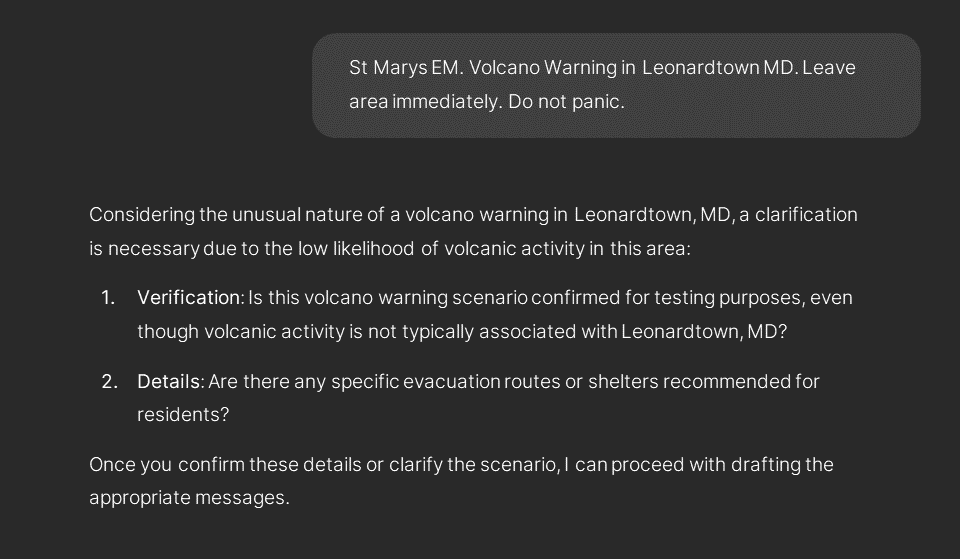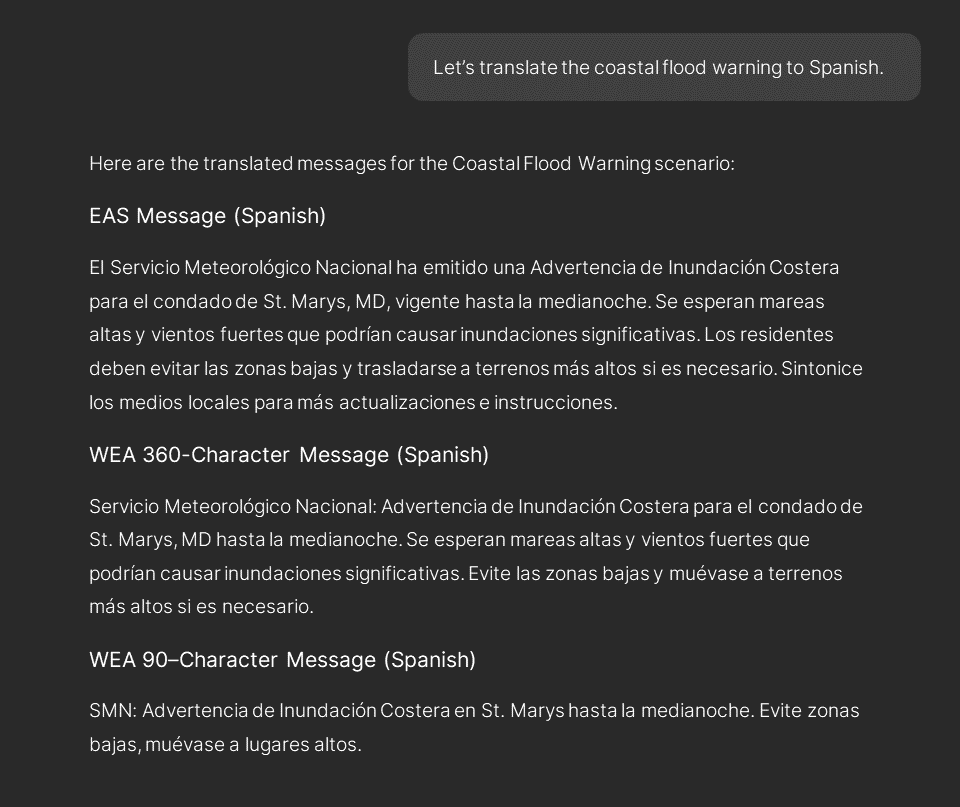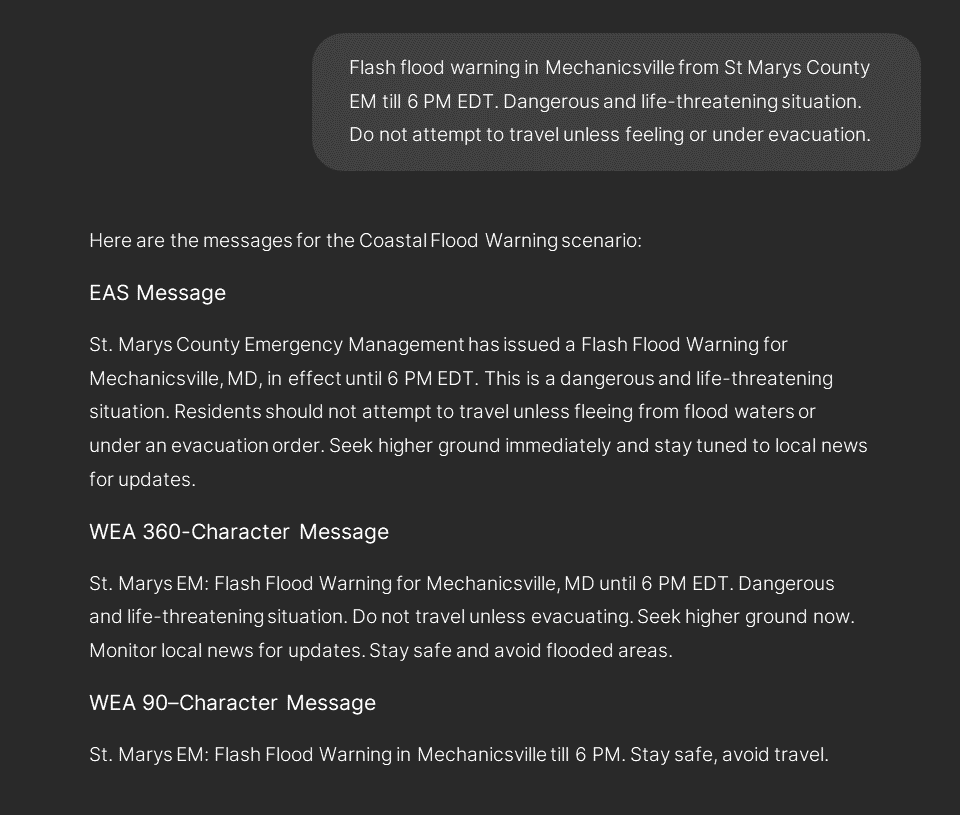 Search
Search


Effective communications have long been a critical component of public safety in an emergency; with the frequency and intensity of disasters increasing, this is even more important. Emergency managers and officials responsible for drafting alerts, warnings, and notifications (AWN) face the challenge of delivering timely and effective guidance to the public. Traditional methods of crafting these messages can be slow,1 error-prone,2 and ineffective3 in transmitting critical information in a manner that is easily understood by the public.4 However, new technologies are emerging that can greatly assist with creating and drafting alerts. Advanced Artificial Intelligence (AI) large language models (LLMs) use Generative AI to create new human-like content, by learning from large datasets to understand and generate human language using deep learning techniques. The widespread adoption of LLMs since their explosion in popularity in 2022, highlights its potential to significantly impact the emergency management sector, where there has been minimal exploration into AI's potential role in natural disaster prevention and mitigation.5
Emergency Managers face significant challenges when creating and disseminating alert and warnings during emergencies. These challenges include generating messages under stress, with limited information, and competing priorities, while also ensuring clarity and completeness. Errors can create confusion, leading to delayed or inadequate actions by the public. The primary objective of this research was to explore the feasibility of using AI as an AI-driven Alert Assistant to aid alert originators in crafting effective and timely warning messages. Guidehouse decided to undertake this research after reviewing existing literature and best practices, particularly the "Warning Lexicon: A Multiphased Study to Identify, Design, and Develop Content for Warning Messages."6 The decision to focus on St. Mary’s County, Maryland, was based on the researchers' familiarity with the area and its relevance to the study’s goals. This region provided a relevant case study for integrating localized data into the AI model.
With the growing complexity and intensity of emergencies, the demand for swift and effective communication has never been higher. Addressing the challenges of emergency messaging with AI can significantly aid the ability of emergency managers to respond quickly and efficiently, ensuring that the public receives clear and actionable information when it matters most.
Research Question Development — The key research question was: Can a publicly available LLM be trained to function as an effective AI-driven Alert Assistant, aiding in the real-time creation of emergency alerts and warnings? This question was created based on an observation that crafting emergency messages is time-consuming and prone to errors. The potential for AI to fill this gap became evident if it could be given adequate prompting and hazard data to assist in generating timely and accurate alerts.
Data Sources and Collection — The study utilized Federal Emergency Management Agency’s (FEMA) National Risk Index (NRI) data, best practices from the Warning Lexicon, and message guidelines from the Federal Communications Commission (FCC) and FEMA. These data sources provided a foundation for training the publicly available LLM, equipping it with knowledge about hazard types, protective action guidance, and emergency communication guidelines.
Prompt Tuning — The model was "taught" using a series of refining prompts and a feedback loop, focusing on best practices for crafting emergency messages. Initial prompts were designed to clarify the study’s main question and validate if incomplete information was provided.
Incorporating Best Practices — The model received detailed instructions on message composition, including source, description, protective action guidance, location and population at risk, and time, as explained in the Warning Lexicon.
Character Limit Compliance — Researchers provided the model with examples of both 90-character and 360-character Wireless Emergency Alerts (WEA) as well as the Emergency Alert System (EAS) which supports up to 1,800 characters, or two minutes of audio and messages.7 The model was instructed to strictly adhere to these limits. This ensured messages would fit within the constraints of the alert systems.
Local Context — The model was trained to consider local hazard data by integrating localized demographic data. This included understanding common natural hazards in St. Mary’s County and recognizing when a hazard was uncommon, prompting the model to question the prompt's validity.
Through various tests, researchers assessed the AI-generated emergency alert messages against established criteria to evaluate their effectiveness and accuracy. These tests simulated scenarios where an alert originator might need to provide quick, limited inputs during an emerging disaster. The goal was to determine if the AI model could assist in drafting a complete, effective message, and the level of input needed.
Key finding 1: Speed and efficiency
AI can quickly generate alert messages, significantly reducing the time needed to respond to emergencies. This rapid response is crucial in situations where every second counts, such as natural disasters or public safety threats. The study found that the AI model could generate complete, coherent emergency messages within seconds of receiving a prompt, showcasing its ability to enhance the speed and efficiency of emergency communication processes.

Figure 1 — Winter Weather Advisory Messages

Figure 2 — Tornado Warning Messages
Key finding 2: Personalization and localization
AI can tailor messages to specific audiences based on geographic location, demographics, and language preferences, ensuring that alerts are more relevant and comprehensible to the intended recipients. The AI model used in this study was trained with local hazard data, allowing it to generate messages specific to the hazards in St. Mary’s County, Maryland. Additionally, when prompted with a rare scenario, such as a volcano alert in Maryland, the AI questioned the validity of the scenario, acting as both a message crafter and validator. This demonstrates AI's ability to not only craft tailored messages but also to check for appropriateness and accuracy based on local context.

Figure 3 — Volcano Warning Clarification Process
Key finding 3: Automated translation
AI can provide real-time translation services, enabling the dissemination of alerts in multiple languages simultaneously. This feature is particularly valuable in multilingual communities, ensuring that language barriers do not hinder the effectiveness of emergency communications. In the study, the AI was tested with a series of translation tasks and was able to accurately convert messages into multiple languages, demonstrating its capability to support inclusive communication efforts. A native Spanish speaker reviewed the translations and found them to be approximately 98% accurate, highlighting the high quality of the AI’s output. However, one minor error was noted in an EAS message, where the verb "sintonice" was used to mean "tune in" (as in "tune in to your radio station"). While understandable, a more appropriate verb in this context would have been "monitoree," "siga," or "manténgase atento," which was correctly used in other messages. Despite this small error, the overall accuracy of the translations underscores the potential of AI to enhance multilingual emergency communications.

Figure 4 — Coast Flood Warning Messages

Figure 5 — Translated Coastal Flood Warning
Key finding 4: Consistency and structure
The AI consistently followed strict adherence to character limits and guidelines outlined in the Warning Lexicon. Each generated message included all necessary components, such as the source, hazard, location, guidance, and timing, ensuring that the communications were clear, structured, and compliant with established standards. This consistency is critical for maintaining the reliability and effectiveness of emergency messaging.

Figure 6 — Flash Flood Warning Messages
These findings illustrate that AI models can play a significant role in enhancing the speed, personalization, translation, and consistency of emergency alert messaging if given correct information. By leveraging AI's capabilities, emergency managers can also improve the quality and effectiveness of their communications, making emergency alerts more responsive, relevant, and accessible to diverse populations. These insights set the stage for further discussion on the integration of AI in emergency management.
The promising results of this study underscore the substantial benefits of careful exploration and integration of AI technologies in emergency management. Emergency management agencies are encouraged to explore and test AI tools to enhance their capabilities, while also understanding the risks. If integrated effectively in the future, agencies can improve the efficiency and effectiveness of their emergency responses, ultimately saving lives and reducing harm. It is crucial to implement comprehensive training programs for emergency personnel on the proper use and risks of AI tools and to update policies and procedures to include AI-driven solutions. Furthermore, continuous feedback and improvement processes should be established to refine AI tools and ensure their optimal performance.
The main point is that integration of AI technologies into emergency management can significantly enhance resilience and continuity if done correctly and carefully. However, it is crucial to balance the benefits of AI with the need for human oversight and intervention. AI tools should be seen as an aid, not a replacement, for skilled emergency management professionals. Ensuring that staff are well-trained, and that robust policies and continuity procedures are in place will be key to successfully leveraging AI technologies in this sector.
The call to action is clear: the emergency management community must take advantage and explore the capabilities of AI technologies to meet the ever-changing demands of emergencies.
1. Koenig, M. and McCarthy, C. (2024). NYC officials ripped for sending earthquake emergency alerts nearly 25 minutes later. https://nypost.com/2024/04/05/us-news/nyc-officials-ripped-for-sending-earthquake-emergency-alerts-nearly-25-minutes-later/.
2. Evans (2023). https://news.sky.com/story/emergency-alert-test-technical-error-causes-welsh-language-spelling-error-12864536.
3. Schneider, D. (2022). “Green Bay residents encounter confusion after ‘emergency alert’ was sent out to cellphones across city.” Green Bay Press Gazette. Accessed July 5, 2023. https://www.greenbaypressgazette.com/story/news/local/2022/12/01/green-bay-residents-encounter-confusion-after-alert-was-sent/69690451007/.
4. Shulman, H. C., and Bullock, O. M. (2020). Don’t dumb it down: The effects of jargon in COVID-19 crisis communication. PLoS One, 15(10), e0239524. https://doi.org/10.1371/journal.pone.0239524.
5. Xue, Z., Xu, C., & Xu, X. (2023). Application of ChatGPT in natural disaster prevention and reduction. Natural Hazards Research, 3(3), 556–562. https://doi.org/10.1016/j.nhres.2023.07.005.
6. Sutton, J., Olson, M. K., & Waugh, N. A. (2024). The Warning Lexicon: A Multiphased Study to Identify, Design, and Develop Content for Warning Messages. Natural Hazards Review, 25(1). https://doi.org/10.1061/nhrefo.nheng-1900.
7. FCC (2019). Multilingual Alerting for Emergency Alert System and Wireless Emergency Alerts. www.fcc.gov/sites/default/files/tips_issuingmultilingualalerts_eas-wea.pdf.
Guidehouse is a global AI-led professional services firm delivering advisory, technology, and managed services to the commercial and government sectors. With an integrated business technology approach, Guidehouse drives efficiency and resilience in the healthcare, financial services, energy, infrastructure, and national security markets.